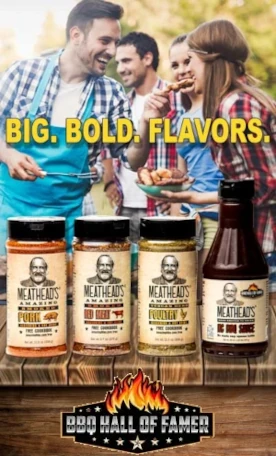Why, yes you can.
While 1-inch steaks may be best cooked using what I call the Quick Flip Flip Flip Flip method over a very hot heat source, sometimes getting a little smokey flavor into them by reverse searing can be a tasty thing. The trick is to do it without overcooking such a thin piece of meat. Most sources recommend a minimum of 1 1/2 inches in thickness for steaks when using the reverse sear method.
The Backstory: Every year around Father's Day, 1 inch thick, about 1 lb Porterhouse steaks go on sale for $10 each at our local grocery. I lay in a supply of them for when the herd (er, offspring) comes to visit in July. They all love a charcoal-grilled, lightly smoky-flavored steak. So here's how I reverse sear them to get some of that smoke flavor into the meat before searing them off.
1lb 2 oz porterhouse steaks, cut 1" thick, dry brined for a minimum of an hour in the fridge. Kept in the part of the fridge that hovers around 30°F.
Weber Summit Charcoal Grilling Center (Mr. Fancypants), in kamado mode.
Takes just under half an hour to get the WSCGC stabilized at 200-225° after lighting the coals. At this point the smoke color is lightly white.
Takes about half an hour after that to get the steaks to 120°
1 3/4 scoops KBB . A Weber scoop is 40 coals or half a chimney.
1 chunk Jack Daniels Oak Barrel stave placed close to the Snapjet on top of the coals
5 min Snapjet ignition
Fireboard Needle probes for steaks plus 2 ambient probes for grate temp.
Put the cold steaks on when the grate temp reached 190-200°.
Removed steaks one at at a time as they approached 120°.
As soon as the steaks were added to the kamado, turned on the Summit gasser, flipped a couple of Grill Grates to solid side up, and monitored the surface temp to get no hotter than 500-600° so there's no burning for the first sear. (After the first seared side, I crank the burners up to high for the remaining 3 Flips.)
Patted the top dry, sprayed with Duck Fat Spray (or brushed with brisket tallow) and seared quickly, flipping every 30 seconds or less, twice per side.
Sprinkled on Oak Ridge BBQ's Carne Crosta, Uncle Chris's or Hank's Signature Blend after each steak had been flipped to the second side. Repeated for the other side when it got flipped back up. That way the rub doesn't burn, since the 3rd and 4th flips are pretty short .
Tried to get at least one side, (what I call the Public Side) nicely seared without too much grey zone resulting in the bites. I let the other side take care of itself (it usually looks pretty good anyway).
You can't get a hard sear with this method, but you get enough of a sear so that the flavor is there.


Kathryn
While 1-inch steaks may be best cooked using what I call the Quick Flip Flip Flip Flip method over a very hot heat source, sometimes getting a little smokey flavor into them by reverse searing can be a tasty thing. The trick is to do it without overcooking such a thin piece of meat. Most sources recommend a minimum of 1 1/2 inches in thickness for steaks when using the reverse sear method.
The Backstory: Every year around Father's Day, 1 inch thick, about 1 lb Porterhouse steaks go on sale for $10 each at our local grocery. I lay in a supply of them for when the herd (er, offspring) comes to visit in July. They all love a charcoal-grilled, lightly smoky-flavored steak. So here's how I reverse sear them to get some of that smoke flavor into the meat before searing them off.
1lb 2 oz porterhouse steaks, cut 1" thick, dry brined for a minimum of an hour in the fridge. Kept in the part of the fridge that hovers around 30°F.
Weber Summit Charcoal Grilling Center (Mr. Fancypants), in kamado mode.
Takes just under half an hour to get the WSCGC stabilized at 200-225° after lighting the coals. At this point the smoke color is lightly white.
Takes about half an hour after that to get the steaks to 120°
1 3/4 scoops KBB . A Weber scoop is 40 coals or half a chimney.
1 chunk Jack Daniels Oak Barrel stave placed close to the Snapjet on top of the coals
5 min Snapjet ignition
Fireboard Needle probes for steaks plus 2 ambient probes for grate temp.
Put the cold steaks on when the grate temp reached 190-200°.
Removed steaks one at at a time as they approached 120°.
As soon as the steaks were added to the kamado, turned on the Summit gasser, flipped a couple of Grill Grates to solid side up, and monitored the surface temp to get no hotter than 500-600° so there's no burning for the first sear. (After the first seared side, I crank the burners up to high for the remaining 3 Flips.)
Patted the top dry, sprayed with Duck Fat Spray (or brushed with brisket tallow) and seared quickly, flipping every 30 seconds or less, twice per side.
Sprinkled on Oak Ridge BBQ's Carne Crosta, Uncle Chris's or Hank's Signature Blend after each steak had been flipped to the second side. Repeated for the other side when it got flipped back up. That way the rub doesn't burn, since the 3rd and 4th flips are pretty short .
Tried to get at least one side, (what I call the Public Side) nicely seared without too much grey zone resulting in the bites. I let the other side take care of itself (it usually looks pretty good anyway).
You can't get a hard sear with this method, but you get enough of a sear so that the flavor is there.
Kathryn














Comment